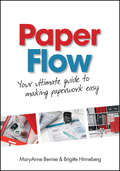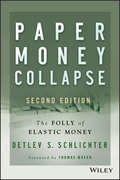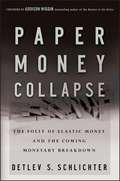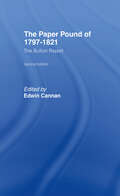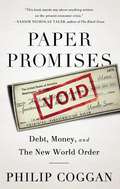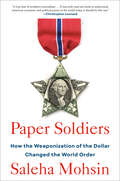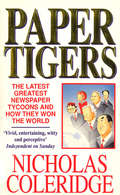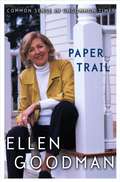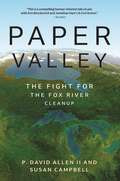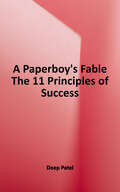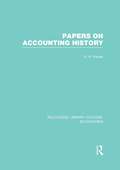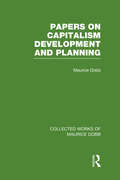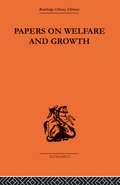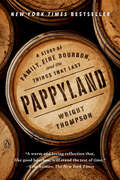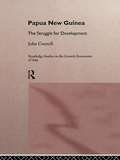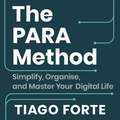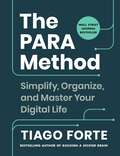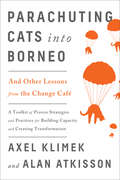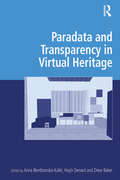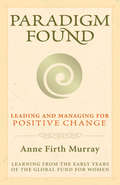- Table View
- List View
Paper Flow: Your Ultimate Guide to Making Paperwork Easy
by Brigitte Hinneberg Maryanne BennieTame your paperwork beast in just 10 minutes a day! Are you wasting your hard earned money on late fees and fines? Does your inbox look more like an outhouse? Do you lose precious time searching for receipts, forms, or other important documents? <P><P>Do you wonder what it would be like if you had a reliable, easy-to-use paper management system to restore order to your life? Stop wondering. The perfect guide for anyone who dreams of digging out from under their paperwork nightmare, Paper Flow arms you with a beautifully simple system for handling all the paper in your life. Never again will you waste valuable time on mad hunts through purses and pockets and piles of disparate papers for airline tickets, prescriptions, vouchers, invitations, phone numbers, or winning lottery tickets. With minimal effort, and just ten minutes a day, you'll conquer routine tasks like paying bills, handling correspondence, and filing. And you'll manage projects at home or work in less time than you ever thought possible. A simple, easy-to-use system for getting on top of your paperwork and keeping it organized and flowing A companion website features checklists, templates, plus a free program, The 28 Day Challenge, that helps you start bringing your paperwork beast to heel right away Provides a framework that allows you to create a system that's tailor-made for your needs and lifestyle
Paper Money Collapse
by Thomas Mayer Detlev S. SchlichterExplore the inevitable collapse of the fiat monetary system Paper Money Collapse: The Folly of Elastic Money, SecondEdition challenges the mainstream consensus on money andmonetary policy. While it is today generally believed that thetransition from 'hard' and inflexible commodity money (such as agold standard) to entirely flexible and potentially unlimited fiatmoney under national central banks allows for superior economicstability, Paper Money Collapse shows that the opposite istrue. Systems of highly elastic and constantly expanding money arenot only unnecessary, even for growing economies, they are alwaysextremely destabilizing. Over time, they must lead to substantialimbalances, including excessive levels of debt and distorted assetprices, that will require ever faster money production to sustain.Ultimately, however, there is no alternative to a completeliquidation of these distortions. Based on insights of manyrenowned economists and in particular of the Austrian School ofEconomics, the book explains through rigorous logic and in preciselanguage why our system of flexible fiat money is incompatible witha market economy and therefore unsustainable. Paper money systemshave always led to economic disintegration--withoutexception--throughout history. It will not be different forour system and we may be closer to the endgame than many think.The updated second edition incorporates:A new introduction and an extended outlook section thatdiscusses various "endgames"Responses to criticisms, alternative views, and a criticalassessment of 'solutions'Comments on recent policy trends, including attempts to exitthe 'easy money' policy modeAn evaluation of new crypto-currency BitcoinPaper Money Collapse: The Folly of Elastic Money, SecondEdition clarifies the problem of paper money clearly andeloquently, and proposes multiple routes to a solution.
Paper Money Collapse
by Detlev S. SchlichterThe case for the inevitable failure of a paper money economy and what that means for the futureAll paper money systems in history have ended in failure. Either they collapsed in chaos, or society returned to commodity money before that could happen. Drawing upon novel new research, Paper Money Collapse conclusively illustrates why paper money systems--those based on an elastic and constantly expanding supply of money as opposed to a system of commodity money of essentially fixed supply--are inherently unstable and why they must lead to economic disintegration.These highly controversial conclusions clash with the present consensus, which holds that elastic state money is superior to inflexible commodity money (such as a gold standard), and that expanding money is harmless or even beneficial for as long as inflation stays low. Contradicting this, Paper Money Collapse shows that:The present crisis is the unavoidable result of continuously expanding fiat moneyThe current policy of accelerated money production to "stimulate" the economy is counterproductive and could lead to a complete collapse of the monetary systemWhy many in financial markets, in media, and in the policy establishment are unable (and often unwilling) to fully appreciate the underlying problems with elastic moneyThis compelling new book looks at the breakdown of modern economic theory and the fallacy of mathematical models. It is an analysis of the current financial crisis and shows in very stark terms that the solutions presented by paper money-enthusiasts around the world are misguided and inherently flawed.
Paper Pound, 1797-1812: A Reprint Of The Bullion Report
by Edwin CannanFirst Published in 1970. Routledge is an imprint of Taylor & Francis, an informa company.
Paper Promises: Debt, Money, and the New World Order
by Philip CogganFrom the "Economist"OCOs award-winning Buttonwood columnist comes a timely and incisive analysis of debt: the defining feature of our financial era
Paper Soldiers: How the Weaponization of the Dollar Changed the World Order
by Saleha Mohsin"Incisive debut treatise... Mohsin brings to the proceedings a reporter's eye for story" — Publisher's WeeklyFrom Bloomberg News reporter Saleha Mohsin, the untold story of how one of America&’s most invincible institutions—the Treasury—has used the U.S. dollar to define America&’s role in the world, and our economic future.In 1995, Treasury Secretary Robert Rubin re-defined the next thirty years of currency policy with the mantra, &“A strong dollar is in America&’s interest.&” That mantra held, ushering in exceptional prosperity and cheap foreign goods, but the strong dollar policy also played a role in the devastating hollowing out of America&’s manufacturing sector. Meanwhile, abroad, the United States increasingly turned to the dollar as a weapon of war. In Paper Soldiers, Saleha Mohsin reveals how the Treasury Department has shaped U.S. policy at home and overseas by wielding the American dollar as a weapon—and what that means in a new age of crisis.For decades, America has preferred its currency superpower-strong, the basis of a "strong dollar" policy that attracted foreign investors and pleased consumers. Drawing on Mohsin's unparalleled access to current and former Treasury officials like Robert Rubin, Steven Mnuchin, and Janet Yellen, Paper Soldiers traces that policy's intended and unintended consequences, including the rise of populist sentiment and trade war with China—culminating in an unprecedented attack on the dollar&’s pristine status during the Trump presidency—and connects the dollar's weaponization from 9/11 to the deployment of crippling financial sanctions against Russia. Ultimately, Mohsin argues that, untethered from many of the economic assumptions of the last generation, the power and influence of the American dollar is now at stake.With first-hand reporting and fresh analysis that illustrates the vast, often unappreciated power that the Treasury Department wields at home and abroad, Paper Soldiers tells the inside story of how we really got here—and the future not only of the almighty dollar, but the nation&’s teetering role as a democratic superpower.
Paper Tigers
by Nicholas ColeridgePaper Tigers is a riveting, authoritative and in-depth study of newspaper barons of the world – men and women who wield immense power, and whose ever-changing media empires make compelling case studies of business success and failure.From Rupert Murdoch to Robert Maxwell, Conrad Black to Lord Rothermere, Katharine Graham to Punch Sulzberger, Coleridge interviewed them all. The results confirm his status as a devastatingly astute observer of our times, one with few equals today.
Paper Trail
by Ellen GoodmanIn this rich and savvy collection of commentaries on the events, people and issues that shape and define our world, Pulitzer Prize-winning columnist and New York Times bestselling author Ellen Goodman cuts to the heart of the stories and controversies that helped to define our times. For over twenty-five years, nationally syndicated columnist Ellen Goodman has been training her lens on contemporary American life. A marvelously direct writer with keen insight into what makes the average American tick, laugh and occasionally boil with rage, Goodman takes her measure of the national psyche in a voice that is at once perceptive, witty and deeply humane. Paper Trail, her first collection in more than ten years, journeys through an era that has been golden in its advances and bleak in its disappointments. In a voice both reasoned and impassioned, she makes sense of the cultural debates that have captured our attention and sometimes become national obsessions. She wrestles with the close-to-the-bone issues of abortion, working mothers and gay marriage, the struggles for civil liberties and equal rights, and the moral complexity of assisted suicide and biotech babies. As she wends through the era of the Clinton scandals and the "amBushing" of America, the dot-com boom and bust, the horrors of September 11 and the War on Terrorism, Goodman pauses to celebrate some of our lost icons, including Jackie Onassis, Princess Diana and Doctor Spock. She reminds us as well of the fleeting fame of such instant celebrities as Elian Gonzalez and Lorena Bobbitt. The lines that separate public and private life dissolve under Goodman's scrutiny as she shows us how Washington politics, Silicon Valley technology and the national media culture infiltrate our jobs, relationships and minds. With the trademark clarity that readers count on, she walks us through the dilemmas posed by new technologies that range from cloning to cell phones and makes us laugh at the vagaries of Viagra and Botox and unreality TV. And in a world that sometimes seems to be stuck on fast forward, she holds on to values as timeless as a family Thanksgiving and a summer porch in Maine. Including more than 160 of Ellen Goodman's lively and stylish columns, this timely collection walks us along the paper trail in a voice that is both crystal clear and original.
Paper Valley: The Fight for the Fox River Cleanup (Great Lakes Books Series)
by David Allen Susan CampbellBooklist raves, Paper Valley "is a compelling human-interest tale on par with Erin Brockovich and Jonathan Harr's A Civil Action." When government scientist David Allen arrived at his new jobsite in the 1990s, the Fox River near Wisconsin's Green Bay was dominated by hulking paper mills, noxious industrial odors, and widespread ecological damage. Confronted by his lack of resources to force the politically powerful "Paper Valley" polluters to fix their mess, Allen proceeds against all bureaucratic odds in building a $1 billion case against the paper company bosses. Two small but vital players, Allen along with journalist Susan Campbell were relentless in bringing the case to the public at the time. They do so again in this book: an act of radical transparency to uncover the intrigue that nearly blocked the cleanup behind the scenes at US Fish and Wildlife, Wisconsin’s Department of Natural Resources, and the US Environmental Protection Agency. In a rare and major environmental win, the Fox River became the site of the largest polychlorinated biphenyls cleanup in history, paid for by the paper companies rather than taxpayers, to the tune of $1.3 billion, and completed in 2020. This true story of struggle, perseverance, and success inspires hope for environmentalists who strive to restore natural landscapes. The detailed account given in this book is meant to inspire and offer practical knowledge and solutions for those fighting similar opponents of environmental cleanup and restoration. Allen and Campbell eloquently outline the problematic bureaucracy involved in environmental cleanup efforts and reveal tactics to compel corporate entities who would dodge accountability for decades worth of contamination. Paper Valley is printed on recycled paper.
A Paperboy's Fable: The 11 Principles of Success
by Deep PatelA young man learns that there is more to being successful than the bottom line. A Paperboy's Fable is a concise, entertaining fable that makes revolutionary points using age-old principles. Whether someone is opening a lemonade stand or leading a startup software company, the 11 Principles of Success make A Paperboy's Fable a timeless tale that is as fresh as it is universal. A Paperboy's Fable also features interviews with many professors, entrepreneurs, CEO’s and General David Petraeus.
Papers on Accounting History (Routledge Library Editions Accounting #57)
by R. H. ParkerWritten over a period of twenty years the papers included here reflect the changing circumstances around the study of accounting history.
Papers on Capitalism, Development and Planning
by Maurice DobbThis volume consists of lectures and articles by Maurice Dobb selected from among those delivered or written by him during the 1950s and 60s. It includes three lectures delivered at the University of Bologna on ‘Some Problems in the History of Capitalism’, two lectures on economic development given at the Delhi School of Economics, articles on the theory of development, and a number of articles on various questions of soviet economic planning contributed to specialist journals. The collection ends with a note in retrospect on Marx’s Das Kapital published in recognition of the centenary of the appearance of Volume One of that work in 1867.
Papers on the Science of Administration (The\making Of Sociology Ser.)
by Kenneth ThompsonThis edited collection includes contributions by Mary Parker Follett, Henri Fayol, James D. Mooney and Henry S. Dennison, and L. J. Henderson, T. N. Whitehead and Elton Mayo. The paper by Henderson, Whitehead and Mayo discusses the findings of the Hawthorne experiments. Whilst admiring the pioneering work of Taylor, these authors criticize scientific management on the grounds that it does not study the facts of human organization. The Hawthorne experiments revealed the importance of spontaneous social organization of the work group into a micro-social system.
Papers on Welfare and Growth
by Tibor ScitovskyThe volume is divided into three parts:A: Economic Growth and Related Problems (covering international trade and economic integration, including a comparative study between Europe and America)B: Theoretical Welfare Economics (welfare propositions in economics, profit maximization and its implications and the Theory of Tariffs)C: Practical Welfare Economics (the price of economic progress, equity and international payments).
Pappyland: A Story of Family, Fine Bourbon, and the Things That Last
by Wright ThompsonThe story of how Julian Van Winkle III, the caretaker of the most coveted cult Kentucky Bourbon whiskey in the world, fought to protect his family's heritage and preserve the taste of his forebears, in a world where authenticity, like his product, is in very short supply. <p><p> As a journalist said of Pappy Van Winkle, "You could call it bourbon, or you could call it a $5,000 bottle of liquified, barrel-aged unobtanium." Julian Van Winkle, the third-generation head of his family's business, is now thought of as something like the Buddha of Bourbon - Booze Yoda, as Wright Thompson calls him. He is swarmed wherever he goes, and people stand in long lines to get him to sign their bottles of Pappy Van Winkle Family Reserve, the whiskey he created to honor his grandfather, the founder of the family concern. A bottle of the 23-year-old Pappy starts at $3000 on the internet. As Julian is the first to say, things have gone completely nuts. <p> Forty years ago, Julian would have laughed in astonishment if you'd told him what lay ahead. He'd just stepped in to try to save the business after his father had died, partly of heartbreak, having been forced to sell the old distillery in a brutal downturn in the market for whiskey. Julian's grandfather had presided over a magical kingdom of craft and connoisseurship, a genteel outfit whose family ethos generated good will throughout Kentucky and far beyond. There's always a certain amount of romance to the marketing of spirits, but Pappy's mission statement captured something real: "We make fine bourbon - at a profit if we can, at a loss if we must, but always fine bourbon." But now the business had hit the wilderness years, and Julian could only hang on for dear life, stubbornly committed to preserving his namesake's legacy or going down with the ship. <p> Then something like a miracle happened: it turned out that hundreds of very special barrels of whiskey from the Van Winkle family distillery had been saved by the multinational conglomerate that bought it. With no idea what they had, they offered to sell it to Julian, who scrambled to beg and borrow the funds. Now he could bottle a whiskey whose taste captured his family's legacy. The result would immediately be hailed as the greatest whiskey in the world - and would soon be the hardest to find. <p> But now, those old barrels were used up, and Julian Van Winkle faced the challenge of his lifetime: how to preserve the taste of Pappy, the taste of his family's heritage, in a new age? The amazing Wright Thompson was invited to be his wingman as he set about to try. The result is an extraordinary testimony to the challenge of living up to your legacy and the rewards that come from knowing and honoring your people and your craft. Wright learned those lessons from Julian as they applied to the honest work of making a great bourbon whiskey in Kentucky, but he couldn't help applying them to his own craft, writing, and his upbringing in Mississippi, as he and his wife contemplated the birth of their first child. May we all be lucky enough to find some of ourselves, as Wright Thompson did, in Julian Van Winkle, and in Pappyland. <p> <b>A New York Times Bestseller</b>
Papua New Guinea: The Struggle for Development (Routledge Studies in the Growth Economies of Asia)
by John ConnellPapua New Guinea is the first book to explore the economic development of this socially complex, rapidly changing nation. Subjects discussed include: * rapid economic growth and political conflict * civil war on the island of Bougainville * population growth and urbanisation * mining: gold, copper and environmental conflicts * uneven development and social divisions.
Papua New Guinea: Selected Issues and Statistical Appendix
by International Monetary FundA report from the International Monetary Fund.
The PARA Method: Simplify, Organise and Master Your Digital Life
by Tiago ForteFrom the bestselling author of Building a Second Brain comes a primer on the essential tools you need to organize your digital life.Living a modern life requires juggling a lot of information. But we were never taught how to manage this material effectively so that we can find what we need when we need it.In The PARA Method, Tiago Forte outlines a simple and intuitive system that can be implemented in just seconds but has the power to transform the trajec tory of your work and life, without the tedious filing or time-consuming maintenance of other approaches. The PARA Method will bring order to your inbox, filing system, notes app and more - so that you can focus on what really matters, moving forward to achieve your goals.
The PARA Method: Simplify, Organize, and Master Your Digital Life
by Tiago ForteThis accessible guide expands upon the &“well-written, cogent, and useful&” (David Allen, author of Getting Things Done) bestselling Building a Second Brain with actionable advice on how to improve your digital life in just a few minutes.Living a modern life requires juggling a ton of information. But we were never taught how to manage this information effectively so that we can find what we need when we need it. In The PARA Method, Tiago Forte outlines a simple and intuitive four-step system that will help us sort all the information flooding our brains into four major categories—Projects, Areas, Resources, and Archives—allowing us to manage our commitments while achieving our goals and dreams. -Projects are specific, short-term efforts that you are actively working on with a certain goal in mind, such as completing a website or renovating your bathroom. -Areas are the larger, ongoing areas of responsibility (health, finances, etc.) that encompass those specific projects. -Resources include content on a range of topics you&’re interested in or that could be useful for your projects and areas. -Archives include anything from the previous three categories that is now inactive, but you want to save for future reference. With his easy-to-understand and engaging voice, Forte outlines his best practices and tips on how to successfully implement PARA, along with deep dives on everything from how to adopt habits to stay organized to how to use this system to enhance your focus. The PARA Method can be implemented in just seconds but has the power to transform the trajectory of your work and life using the power of digital organization.
Parable of the Sadhu (HBR Bestseller)
by Bowen H. MccoyWhen does a group have responsibility for the well-being of an individual? And what are the differences between the ethics of the individual and the ethics of the corporation? Those are the questions Bowen McCoy wanted readers to explore in this HBR Classic, first published in September-October 1983. In 1982, McCoy spent several months hiking through Nepal. Midway through the difficult trek, he encountered an Indian holy man, or sadhu. Wearing little clothing and shivering in the bitter cold, he was barely alive. McCoy and the other travelers immediately wrapped him in warm clothing and gave him food and drink. A few members of the group broke off to help move the sadhu down toward a village two days' journey away, but they soon left him in order to continue their way up the slope. What happened to the sadhu? In his retrospective commentary, McCoy notes that he never learned the answer to that question. On the Himalayan slope, a collection of individuals was unprepared for a sudden dilemma. McCoy asks, how do organizations respond appropriately to ethical crises?
Parables of Leadership
by Renee A. Mauborgne W. Chan KimWhile it is easy to recognize leadership in action, defining the essence of leadership is hard because it cannot be reduced to a set of personal attributes or particular activities. Intent on capturing the essence of leadership, Chan Kim and Renee Mauborgne turned to lessons that Kim had learned as a youth in the temples of Korea's Kyung Nam province. These lessons dealt with the qualities that define true leaders. Their points were made through stories, not through statistics or research. Thus they provided the inspiration for five parables of leadership.
Parachuting Cats into Borneo: And Other Lessons from the Change Café
by Axel Klimek Alan AtkissonA toolkit of proven strategies and practices for building capacity and creating transformation Recent years have seen a proliferation of information on how to make change--in business, in social and environmental movements, and on a more personal scale. But, even with all this attention, two out of three change efforts fail to achieve their desired result. How can you make your own effort buck this trend? In Parachuting Cats into Borneo, change-management experts Axel Klimek and Alan AtKisson offer crisp, concise, and targeted advice for success. They expose the most significant impediments--helping readers recognize their habitual patterns of thinking and perceiving a situation, critique their own beliefs regarding change, and then move beyond these unhelpful patterns using improved systems thinking. Named after a classic tale of unintended consequences, Parachuting Cats into Borneo delivers tools that help leaders and others keep their change initiatives on track. The advice imparted will help you move away from agonizing over immediate problems toward stoking action, identifying collaborators, focusing at the right level for your cause, and aiding others in pursuing their change. Klimek and AtKisson draw from their decades of helping corporations, networks, governments, and NGOs reach their change goals to demonstrate how to use system-based change tools to their maximum advantage. A closing section is devoted to change making in the realm of sustainability, where complexity abounds but the right tools, used well, can help us tackle some of the most significant challenges of our time.
Paradata and Transparency in Virtual Heritage (Digital Research in the Arts and Humanities)
by Anna Bentkowska-Kafel Hugh Denard Drew BakerComputer-Generated Images (CGIs) are widely used and accepted in the world of entertainment but the use of the very same visualization techniques in academic research in the Arts and Humanities remains controversial. The techniques and conceptual perspectives on heritage visualization are a subject of an ongoing interdisciplinary debate. By demonstrating scholarly excellence and best technical practice in this area, this volume is concerned with the challenge of providing intellectual transparency and accountability in visualization-based historical research. Addressing a range of cognitive and technological challenges, the authors make a strong case for a wider recognition of three-dimensional visualization as a constructive, intellectual process and valid methodology for historical research and its communication. Intellectual transparency of visualization-based research, the pervading theme of this volume, is addressed from different perspectives reflecting the theory and practice of respective disciplines. The contributors - archaeologists, cultural historians, computer scientists and ICT practitioners - emphasize the importance of reliable tools, in particular documenting the process of interpretation of historical material and hypotheses that arise in the course of research. The discussion of this issue refers to all aspects of the intellectual content of visualization and is centred around the concept of 'paradata'. Paradata document interpretative processes so that a degree of reliability of visualization outcomes can be understood. The disadvantages of not providing this kind of intellectual transparency in the communication of historical content may result in visual products that only convey a small percentage of the knowledge that they embody, thus making research findings not susceptible to peer review and rendering them closed to further discussion. It is argued, therefore, that paradata should be recorded alongside more tangible outcomes of research, preferably as an integral part of virtual models, and sustained beyond the life-span of the technology that underpins visualization.
Paradigm Capital Value Fund
by Elena Corsi Luis M. ViceiraKarl Jan Erick Hummel had founded Paradigm Capital Value Fund in 2007 together with Columbia Business School Professor Bruce Greenwald, an expert in value investing and now chairman of the fund. The fund followed the principles of value investing to their target universe: publicly traded companies with market capitalization between 100 million and 4.5 billion based in Germany, the Nordic countries, the U.K., and Ireland. Hummel and Greenwald believed they had developed an investing edge in that universe, ignored by large U.S. and U.K. based funds, through deep research and by locating their headquarters close to companies and their management. Hummel and his team of six analysts were based in a small suburb of Munich, Germany. Paradigm Capital Value Fund was highly concentrated, with 60% of its assets invested in four stocks, and held its positions for long periods of time. Hummel had to decide if it was time to divest from one of their main investments, a German manufacturer of roll-over car washing systems, and instead invest in a German truck equipment supplier. At the same time, Hummel was concerned by how to grow the fund.
Paradigm Found
by Anne Firth MurrayA Practical Framework for Positive Social Change In 1987, Anne Firth Murray had the idea that funding should go to grassroots women's organizations around the globe and that the recipients themselves should decide how to use that money. From that idea, The Global Fund for Women was born. The organization became a major force for good in the world, embodying a new paradigm of philanthropy. In these pages, Murray shares her wisdom, offering guidelines that demonstrate how anyone can turn a clear vision of a better world into reality.
